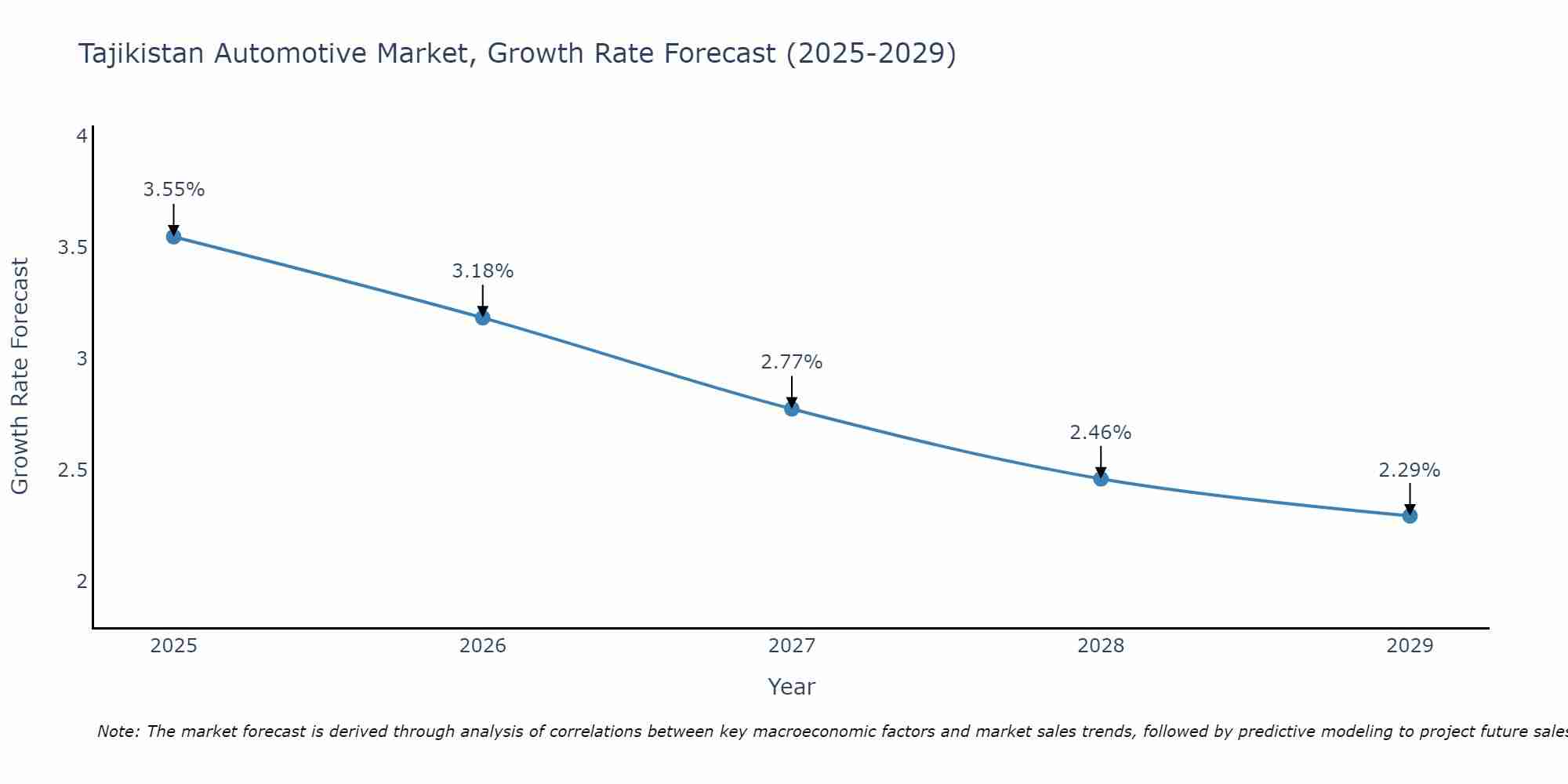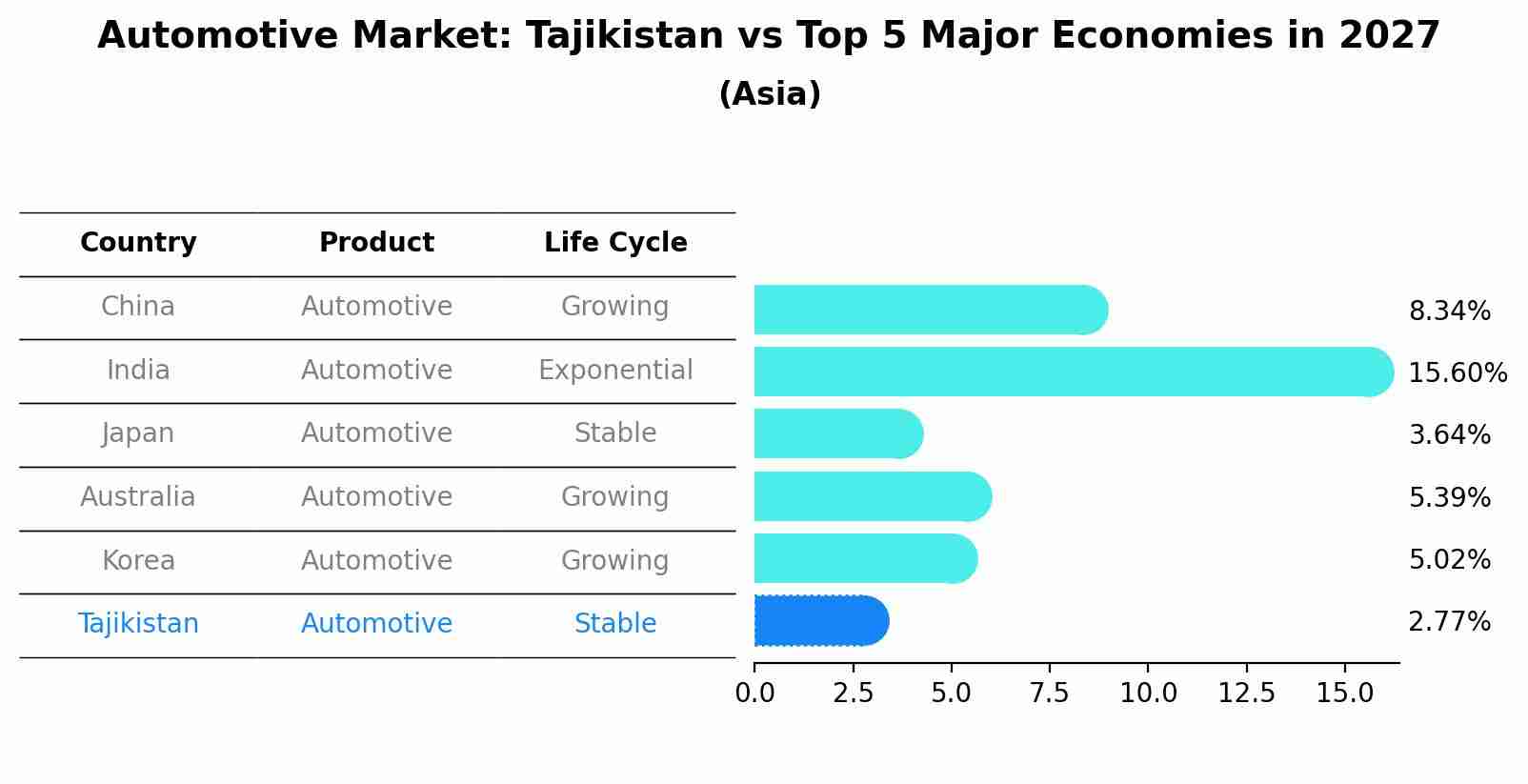Tajikistan Automotive Market Outlook | Industry, Analysis, COVID-19 IMPACT, Forecast, Share, Size, Trends, Companies, Value, Growth & Revenue
| Product Code: ETC431815 | Publication Date: Oct 2022 | Updated Date: Jul 2025 | Product Type: Market Research Report | |
| Publisher: 6Wresearch | Author: Shubham Deep | No. of Pages: 75 | No. of Figures: 35 | No. of Tables: 20 |
Tajikistan Automotive Market Size Growth Rate
The Tajikistan Automotive Market may undergo a gradual slowdown in growth rates between 2025 and 2029. Starting high at 3.55% in 2025, the market steadily declines to 2.29% by 2029.

Automotive Market: Tajikistan vs Top 5 Major Economies in 2027 (Asia)
Tajikistan's Automotive market is anticipated to experience a stable growth rate of 2.77% by 2027, reflecting trends observed in the largest economy China, followed by India, Japan, Australia and South Korea.

Tajikistan Automotive Market Synopsis
The Tajikistan automotive market is experiencing steady growth with an increasing demand for both new and used vehicles. The market is primarily driven by the growing middle class, improving economic conditions, and infrastructure development in the country. Passenger cars dominate the market, followed by commercial vehicles and two-wheelers. The market is highly competitive, with both domestic and international brands competing for market share. However, high import tariffs and complex customs procedures present challenges for foreign automakers looking to enter the market. Overall, the Tajikistan automotive market presents opportunities for growth, particularly in the passenger car segment, as consumers continue to seek affordable and reliable transportation options.
Tajikistan Automotive Market Trends
In the Tajikistan Automotive Market, there is a growing trend towards increased demand for more fuel-efficient and eco-friendly vehicles. The rise in awareness of environmental issues and the need for sustainable transportation solutions has led to a shift towards electric and hybrid vehicles. Additionally, there is a noticeable increase in the popularity of compact and affordable cars, as consumers seek practical and cost-effective options. The market also reflects a preference for vehicles with advanced safety features and modern technology integration. Overall, the Tajikistan Automotive Market is witnessing a transition towards more sustainable, efficient, and technologically advanced vehicles to meet the evolving needs and preferences of consumers in the region.
Tajikistan Automotive Market Challenges
In the Tajikistan Automotive Market, there are several challenges that impact the industry`s growth and development. One major challenge is the country`s relatively low purchasing power, which limits the demand for new vehicles. High import tariffs and taxes on vehicles also contribute to the high cost of cars, making them unaffordable for many consumers. Additionally, the lack of developed infrastructure, such as poor road conditions and limited access to financing options, hinders the market`s potential for expansion. Political instability and economic uncertainties further add to the challenges faced by automotive companies operating in Tajikistan, leading to a volatile business environment. Overcoming these obstacles will require strategic planning, investment in infrastructure, and government support to stimulate market demand and create a more favorable business climate for the automotive industry.
Tajikistan Automotive Market Investment Opportunities
The Tajikistan automotive market presents several investment opportunities due to increasing demand for vehicles in the country. With a growing middle class and improving economic conditions, there is a rising need for both passenger cars and commercial vehicles. Investing in dealerships, assembly plants, or spare parts manufacturing can be lucrative ventures. Additionally, there is potential for growth in the electric vehicle sector as the government aims to reduce emissions and promote sustainable transportation. Partnerships with local automotive companies or government initiatives promoting the automotive industry could also be beneficial for investors looking to enter the Tajikistan market. Overall, the automotive sector in Tajikistan offers promising opportunities for investors to capitalize on the country`s evolving transportation needs.
Jordan Agar Market Government Policies
The Tajikistan government has implemented policies to promote the development of the automotive market in the country. One key policy is the reduction of import duties on vehicles to stimulate demand and make cars more affordable for consumers. Additionally, the government has introduced regulations to improve road safety standards and reduce vehicle emissions, aligning with global environmental goals. In recent years, there have been efforts to attract foreign investment in the automotive sector through incentives and partnerships, aiming to enhance local production capabilities and create job opportunities. Overall, the government`s policies in Tajikistan`s automotive market focus on increasing accessibility, promoting sustainability, and fostering economic growth in the industry.
Tajikistan Automotive Market Future Outlook
The future outlook for the Tajikistan automotive market is positive, with steady growth expected in the coming years. Factors such as increasing disposable income, improving road infrastructure, and a growing middle class population are anticipated to drive demand for new vehicles. The government`s focus on attracting foreign investment and promoting local manufacturing in the automotive sector is also likely to contribute to the market`s expansion. However, challenges such as high import tariffs, limited access to financing, and competition from used car imports may pose some obstacles to growth. Overall, with the ongoing economic development and favorable demographic trends, the Tajikistan automotive market is poised for gradual expansion and diversification in the foreseeable future.
Key Highlights of the Report:
- Tajikistan Automotive Market Outlook
- Market Size of Tajikistan Automotive Market, 2021
- Forecast of Tajikistan Automotive Market, 2031
- Historical Data and Forecast of Tajikistan Automotive Revenues & Volume for the Period 2018 - 2031
- Tajikistan Automotive Market Trend Evolution
- Tajikistan Automotive Market Drivers and Challenges
- Tajikistan Automotive Price Trends
- Tajikistan Automotive Porter's Five Forces
- Tajikistan Automotive Industry Life Cycle
- Historical Data and Forecast of Tajikistan Automotive Market Revenues & Volume By Product Type for the Period 2018 - 2031
- Historical Data and Forecast of Tajikistan Automotive Market Revenues & Volume By Electric for the Period 2018 - 2031
- Historical Data and Forecast of Tajikistan Automotive Market Revenues & Volume By Hybrid Electric for the Period 2018 - 2031
- Historical Data and Forecast of Tajikistan Automotive Market Revenues & Volume By Plug-In Hybrid Electric for the Period 2018 - 2031
- Historical Data and Forecast of Tajikistan Automotive Market Revenues & Volume By Mild Hybrid for the Period 2018 - 2031
- Historical Data and Forecast of Tajikistan Automotive Market Revenues & Volume By Natural Gas for the Period 2018 - 2031
- Historical Data and Forecast of Tajikistan Automotive Market Revenues & Volume By Fuel Cell Electric for the Period 2018 - 2031
- Historical Data and Forecast of Tajikistan Automotive Market Revenues & Volume By Diesel for the Period 2018 - 2031
- Historical Data and Forecast of Tajikistan Electric Automotive Market Revenues & Volume By Petrol for the Period 2018 - 2031
- Tajikistan Automotive Import Export Trade Statistics
- Market Opportunity Assessment By Product Type
- Tajikistan Automotive Top Companies Market Share
- Tajikistan Automotive Competitive Benchmarking By Technical and Operational Parameters
- Tajikistan Automotive Company Profiles
- Tajikistan Automotive Key Strategic Recommendations
Frequently Asked Questions About the Market Study (FAQs):
- Single User License$ 1,995
- Department License$ 2,400
- Site License$ 3,120
- Global License$ 3,795
Search
Thought Leadership and Analyst Meet
Our Clients
Related Reports
- Canada Oil and Gas Market (2026-2032) | Share, Segmentation, Value, Industry, Trends, Forecast, Analysis, Size & Revenue, Growth, Competitive Landscape, Outlook, Companies
- Germany Breakfast Food Market (2026-2032) | Industry, Share, Growth, Size, Companies, Value, Analysis, Revenue, Trends, Forecast & Outlook
- Australia Briquette Market (2025-2031) | Growth, Size, Revenue, Forecast, Analysis, Trends, Value, Share, Industry & Companies
- Vietnam System Integrator Market (2025-2031) | Size, Companies, Analysis, Industry, Value, Forecast, Growth, Trends, Revenue & Share
- ASEAN and Thailand Brain Health Supplements Market (2025-2031) | Strategy, Consumer Insights, Analysis, Investment Trends, Opportunities, Growth, Size, Share, Industry, Revenue, Segments, Value, Segmentation, Supply, Forecast, Restraints, Outlook, Competition, Drivers, Trends, Demand, Pricing Analysis, Competitive, Strategic Insights, Companies, Challenges
- ASEAN Bearings Market (2025-2031) | Strategy, Consumer Insights, Analysis, Investment Trends, Opportunities, Growth, Size, Share, Industry, Revenue, Segments, Value, Segmentation, Supply, Forecast, Restraints, Outlook, Competition, Drivers, Trends, Demand, Pricing Analysis, Competitive, Strategic Insights, Companies, Challenges
- Europe Flooring Market (2025-2031) | Outlook, Share, Industry, Trends, Forecast, Companies, Revenue, Size, Analysis, Growth & Value
- Saudi Arabia Manlift Market (2025-2031) | Outlook, Size, Growth, Trends, Companies, Industry, Revenue, Value, Share, Forecast & Analysis
- Uganda Excavator, Crane, and Wheel Loaders Market (2025-2031) | Strategy, Consumer Insights, Analysis, Investment Trends, Opportunities, Growth, Size, Share, Industry, Revenue, Segments, Value, Segmentation, Supply, Forecast, Restraints, Outlook, Competition, Drivers, Trends, Demand, Pricing Analysis, Competitive, Strategic Insights, Companies, Challenges
- Rwanda Excavator, Crane, and Wheel Loaders Market (2025-2031) | Strategy, Consumer Insights, Analysis, Investment Trends, Opportunities, Growth, Size, Share, Industry, Revenue, Segments, Value, Segmentation, Supply, Forecast, Restraints, Outlook, Competition, Drivers, Trends, Demand, Pricing Analysis, Competitive, Strategic Insights, Companies, Challenges
Industry Events and Analyst Meet
Whitepaper
- Middle East & Africa Commercial Security Market Click here to view more.
- Middle East & Africa Fire Safety Systems & Equipment Market Click here to view more.
- GCC Drone Market Click here to view more.
- Middle East Lighting Fixture Market Click here to view more.
- GCC Physical & Perimeter Security Market Click here to view more.
6WResearch In News
- Doha a strategic location for EV manufacturing hub: IPA Qatar
- Demand for luxury TVs surging in the GCC, says Samsung
- Empowering Growth: The Thriving Journey of Bangladesh’s Cable Industry
- Demand for luxury TVs surging in the GCC, says Samsung
- Video call with a traditional healer? Once unthinkable, it’s now common in South Africa
- Intelligent Buildings To Smooth GCC’s Path To Net Zero


















